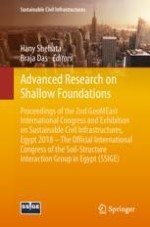2019 | Buch
Advanced Research on Shallow Foundations
Proceedings of the 2nd GeoMEast International Congress and Exhibition on Sustainable Civil Infrastructures, Egypt 2018 – The Official International Congress of the Soil-Structure Interaction Group in Egypt (SSIGE)
herausgegeben von: Dr. Hany Shehata, Prof. Dr. Braja Das
Verlag: Springer International Publishing
Buchreihe : Sustainable Civil Infrastructures
